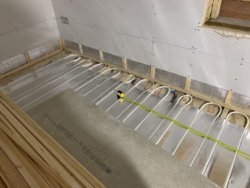Mmark
-
- Reaction score
- 0
We have a 4x3 bedroom with the following 12 spans:
190, 368, 380, 365, 380, 370, 385, 370, 395, 385, 370, 300
The UFH was installed by builders ready for the GifaFloor FHB18 (18mm). FHB18 is rated at 2kn point load when installed to manufacturers instructions, they estimate to reduce that by 50% that, if joins aren't supported by joists. I have the following two questions:
1) The centres are not 400. Which means joins do not line up on joists, so I drop below the 2kn point load: My architect advised me it is not worth pulling up all the UFH to sister joists, which would probably make it impossible to lay spread plates anyway (squeezed too much). He said as this a bedroom with a small(ish) floor area and centres which are all smaller than 400 I will "probably" be ok; because the manufacturers build in a large degree of safety. I've read first floors should be 1.4kn... So if we are potentially half 2kn (1kn) that has left me a little concerned. Anyone had similar experiences and it has been ok?
2) No edge support on one wall: Architect said that holed 35mm x 35mm x 1.5mm to 2mm steel angle iron will work for edge support. Vertically screw at 200mm centres and pink grip to stop squeezing. This sound ok, and anyone got links to good products they'd recommend? I've seen this, Punched Steel Equal Angle Profile - 1m x 35.5 x 35.5mm - https://www.homebase.co.uk/punched-steel-equal-angle-profile-1m-x-35-5-x-35-5mm_p414977 1.5mm. I'm trying to find something a little thicker and longer. Unfortunately my builders need it ASAP, so cannot order from fabricator (such as Home Page - Daver Steels Ltd - https://www.daver-steels-fabrication.co.uk)
190, 368, 380, 365, 380, 370, 385, 370, 395, 385, 370, 300
The UFH was installed by builders ready for the GifaFloor FHB18 (18mm). FHB18 is rated at 2kn point load when installed to manufacturers instructions, they estimate to reduce that by 50% that, if joins aren't supported by joists. I have the following two questions:
1) The centres are not 400. Which means joins do not line up on joists, so I drop below the 2kn point load: My architect advised me it is not worth pulling up all the UFH to sister joists, which would probably make it impossible to lay spread plates anyway (squeezed too much). He said as this a bedroom with a small(ish) floor area and centres which are all smaller than 400 I will "probably" be ok; because the manufacturers build in a large degree of safety. I've read first floors should be 1.4kn... So if we are potentially half 2kn (1kn) that has left me a little concerned. Anyone had similar experiences and it has been ok?
2) No edge support on one wall: Architect said that holed 35mm x 35mm x 1.5mm to 2mm steel angle iron will work for edge support. Vertically screw at 200mm centres and pink grip to stop squeezing. This sound ok, and anyone got links to good products they'd recommend? I've seen this, Punched Steel Equal Angle Profile - 1m x 35.5 x 35.5mm - https://www.homebase.co.uk/punched-steel-equal-angle-profile-1m-x-35-5-x-35-5mm_p414977 1.5mm. I'm trying to find something a little thicker and longer. Unfortunately my builders need it ASAP, so cannot order from fabricator (such as Home Page - Daver Steels Ltd - https://www.daver-steels-fabrication.co.uk)

